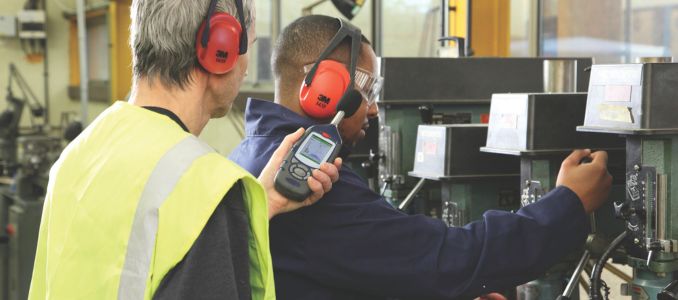
Reducing the Roar
The risk of excessive noise isn’t going away. What are the dangers associated with the unseen hazard and why must employers implement a suitable monitoring program for noisy workplaces?
- By Tim Turney
- May 01, 2025
The world around us is constantly getting louder, posing increasing risk to our hearing and physical health. Hearing loss is the third most common chronic physical condition among adults but it is entirely preventable with appropriate engineering controls and monitoring programs.
Employees are no longer at risk of noise induced hearing loss (NIHL) just in the workplace but also from the environmental noise exposure experienced outside of work. The onus on employers to protect hearing loss at work is more prevalent now than ever before with an estimated 22 million workers in the United States exposed to hazardous noise levels at work.
Exposure to excessive noise levels can lead to more than hearing loss, with research indicating that the likelihood of physical issues such as increased cardiovascular stress, elevated chance of a stroke and developing diabetes. All workers and workplaces are different and require different noise-related solutions, but all noisy workplaces stand to benefit from a rigorous noise monitoring program.
Legislation and Standards for Noise Control
The US controls noise in the workplace at a federal level through legislation delivered by health and safety bodies like the Occupational Safety & Health Administration (OSHA) and the Mine Safety & Health Administration (MHSA). Further local legislation may also apply to noise control by governments or smaller divisions of these health and safety bodies, meaning employers should actively check the local legislation of any territories the business operates in.
The two main overarching legislation are OSHA’s 29 CFR 1910.95 for general industry and 29 CFR 1926.52 specific to the construction industry. These regulations set Permissible Exposure Limits (PELs), ceiling levels of noise at which employers must action monitoring and protection, and require employers to implement hearing conservation programs when noise levels exceed safe thresholds.
The key PEL that employers must be aware of is 85 dBA TWA. Simply put, when noise levels reach 85 decibels (dB) over an 8-hour time weighted average (TWA), employers must conduct noise monitoring and issue hearing protection if necessary.
There are ongoing discussions on the necessity to reduce this action level and some, like the National Institute for Occupational Safety and Health (NIOSH), recommend lower levels and smaller exchange rates. While not legally enforceable, these are considered best practice guidelines.
Workplace Inspections and Noise Monitoring
OSHA inspectors will conduct assessments at sites during scheduled inspections, especially at high risk industries, or if a complaint is raised by members of staff. If noise levels exceed legal limits, inspectors determine whether employers have implemented required hearing conservation programs or engineering controls. If not, they will likely issue penalties of varying amounts, depending on state, with some as large as tens or even hundreds of thousands of dollars. Further failures may even result in work stoppages or business shutdowns.
To prevent these costly fines, employers should regularly conduct noise monitoring assessments, keeping records for compliance purposes. Modern noise monitoring tools such as sound level meters or noise dosimeters should be used.
Sound level meters (SLMs) are handheld pieces of equipment that health and safety managers can use to assess noise exposure in a workplace. SLMs can either be type 1 or type 2, the former being for more detailed precision measurement and the latter for general purpose. Selecting the correct device is imperative for compliance purposes and to ensure employees hearing health is appropriately safeguarded. When selecting an SLM, make sure it meets the ANSI S1.4 standard for sound level meters.
Sound level meters are acceptable tools to use when monitoring workplace noise levels but for the monitoring of workers that are mobile, a noise dosimeter is recommended. Noise dosimeters are bodily worn monitoring tools that attach to an employee close to the ear. These devices provide more accurate individual readings as the employee moves from different work areas given a wholistic understanding of their exposure throughout their working day
Modern noise dosimeters can be Bluetooth enabled and can provide real-assessment directly to the employer’s phone. Data from these readings are then stored remotely and can be accessed at any time for assessment or for compliance purposes. The device records noise levels, ideally over an entire 8-hour workday but can also offer an estimated TWA exposure level if shorter assessment periods are necessary. Dosimeters are small devices designed to be unobtrusive to the wearer to prevent removal during the assessment period and some will even monitor motion so the employer can see if the device as been removed and the results inaccurate.
Noise Control Measures in Workplaces
Noise assessments and regular monitoring helps employers identify the level of risk that employees are exposed to and provide results that can be used to decide on the appropriate corrective action. This could be in the form of engineering controls such as using alternative quieter processes and machinery or, as a last resort, issuing PPE.
Implementing engineering controls is the preferred method of reducing worker exposure. Rotational shifts to move employees away from high riskhigh-risk areas or installing sound barriers around noisy machinery are commonplace in industry. Vibration dampeners and noise absorbing materials can also be used to protect employees from noisy equipment.
If there are no other alternatives and an employee will be exposed to loud levels of noise throughout the day, it is the employer’s responsibility to issue appropriate hearing protection.
Protecting workers from hazardous noise exposure is essential to preventing hearing loss and associated health risks. Through rigorous noise monitoring and effective control measures, employers can safeguard employees’ hearing and well-being, complying with regulations and protecting the business from costly penalties. Advancements in noise monitoring technology further enhance workplace safety, ensuring long-term protection for workers in high-noise environments.
This article originally appeared in the April/May 2025 issue of Occupational Health & Safety.